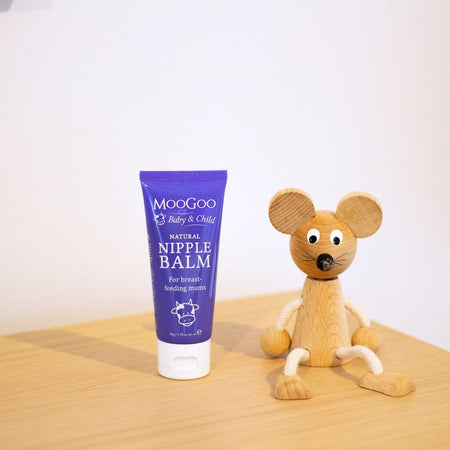MooGoo Natural Nipple Balm 50g
Share or like our products on Facebook & Instagram.
Get your products shipped or pop in and say 'Hello'.
A great opportunity to connect with our team and talk about your individual health needs.
Couldn't load pickup availability
Previously know as: Mudder Udder Balm - New look, same formula!
For Breast Feeding Mums – We’ve made a formula which we believe is the healthiest for your baby while also helping to soothe a sensitive area and keep the skin in good condition. Rather than use Lanolin, we’ve chosen a number of edible and soothing oils and combined them with calming and conditioning ingredients.
To give you one less thing to think about, this balm does NOT need to be removed prior to feeding.
Tips for Avoiding Breast Feeding Discomfort
In an ideal world, breastfeeding will be comfortable. Some mum's and babies have no problems from the start, while for others it can be a struggle – everybody is different. Lactation consultants can help with specific techniques. The following information may also help you need less of our balm :)
Nurse on the best breast first if you have one: Babies often nurse more gently on the second side since they’re less hungry so best breast first to dampen their appetite.
Ensure the correct baby latch: The best latch position is off-centre, with more of the areola below the nipple in your baby's mouth. Try to ensure your baby’s mouth is open with tongue down before inserting the nipple.
Adjust positions: You may find that certain positions make it easier for your baby to latch on correctly and are much more comfortable than others. Experiment to find the best position for you and your baby.
Cold packs: Some mum's find a cold pack before nursing can help to dampen the initial pain of latching.
Clean your nipples gently after breastfeeding: If you have a cracked or bleeding nipple, rinse the breast after each feeding with water to reduce the risk of infection. Some practitioners suggest rinsing the nipple with breast milk. This study found rubbing breast milk on the nipple after feeding worked better than Lanolin in reducing healing times: http://www.ncbi.nlm.nih.gov/pubmed/16127520
- A soothing balm for breast-feeding mums
- Made with antioxidant-rich oils like Grape Seed and Sunflower Oil
- Hydrating and soothing ingredients like Shea Butter and Natural Vitamin E
- Free of Lanolin – a wax secreted by the glands of wool-bearing animals
- Does not need to be removed prior to feeding as the ingredients are edible
- Naturally preserved with Hops Extract – free of Parabens and Phenoxyethanol
INGREDIENTS: Vitis Vinifera (Grape) Seed Oil, Helianthus Annuus (Sunflower) Seed Oil, Calendula Officinalis (Marigold) Flower Extract, Cera Alba (Beeswax), Caprylic Capric Triglyceride (Silky Natural Ester), Butyrospermum Parkii (Shea Butter), Polyglyceryl-3 Diiostearate (Emulsifier), Theobroma Cacao (Cocoa) Seed Butter, Ricinus Communis (Castor) Seed Oil, Lecithin (Soy), Tocopherol (Natural Vitamin E), Humulus Lupulus (Hops) Extract.
We show all the ingredients on our website, not just the pretty ones. That way you can see why we chose them and get in touch if you have any more questions.
Please be aware that ingredients may vary from time to time. Please refer to the ingredient list on the product packaging for the most up-to-date and relevant list of ingredients.
FAQ
My Mudder Udder Balm feels hard. Does this mean it’s gone bad?
Shea Butter can harden in colder climates which can make the balm feel harder and appear grainy. The grains will melt when the balm is warmed up to body temperature when applied to the skin. Or simply run the tube under warm water before use.
Can I use MooGoo on a newborn?
We get this question a lot. But the answer is YES! All of our products are suitable for newborns but we suggest you always patch test first to check for allergies to any natural ingredients. Again, should we add a witty disclaimer to cover ourselves?
My baby accidentally ate some of the product, will they be ok?
We don’t recommend using our products as baby food, but if some is ingested you can rest assured that our products are made from 100% natural, edible ingredients. This means our Mudder Udder Balm does not need to be removed prior to feeding.
What does "Dermatologically Tested" mean?
You may have seen the term “Dermatologically Tested” on lots of products before, but did you know there’s not an actual definition or regulation for this term? Because that didn’t sit right with us, and because our aim is to make products for people with really sensitive skin, we decided to send a bunch of them off to be tested in an independent lab on 54 people who reported having sensitive skin. The results were given on a scale of 0 to 5 with 0 being no irritation or redness and 5 being a reaction. We’re happy to report that other than one person who had a reaction to the adhesive on the patch and another who found the patches painful to remove, all subjects reported 0 for redness and irritation for all the products we sent for testing.









